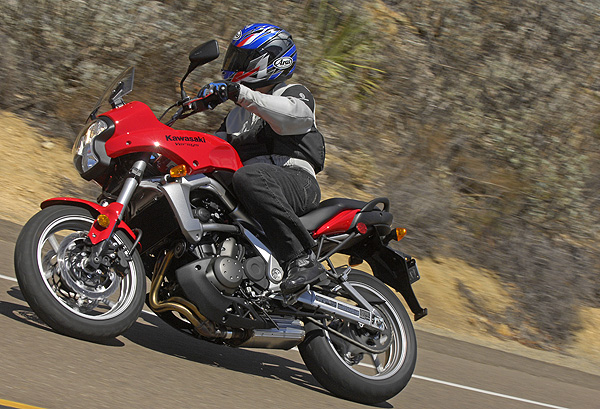
In the distant past, I raced motocross as an amateur. I spent quite a bit of time on dirt bikes, and to this day their ergonomics are more intuitively comfortable for me while riding.
When supermoto became popular in Europe several years ago (eventually migrating to the United States), I remember being excited about the development. Lightweight machines, with upright ergonomics, minimalist styling and longer travel suspension. This seemed like a formula for fun and versatility. I was right, and supermoto-style bikes are catching on . . . even here in the United States where we tend to be a bit slow.
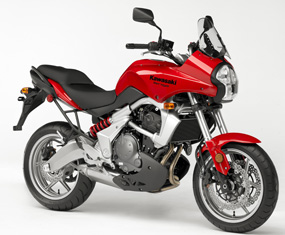
Supermotos look cool in an urban-assault-weapon sort of way. There is a lot of substance behind this look. Substance that revealed itself in several conversations I recently had with knowledgeable motorcyclists and industry representatives.
These conversations started one afternoon while parked with some buddies at the top of a notoriously twisty section of road here in Southern California known as Mt. Palomar. A series of very tight switchbacks are freshly paved in grippy asphalt . . . the perfect playground for street riders who gravitate toward this sort of thing.
The subject of the conversation was the type of bike that would dominate Palomar. Specifically, I offered the opinion that Jeff Ward on his Honda CRF450R-based supermoto race bike (Ward, a motocross legend here in the United States, has become one of the fastest supermoto riders in the world and a U.S. champion in his mid-40s) could beat a road racing champion (name anyone you like, even Valentino Rossi)on a road race bike from the base of Mt. Palomar to the top. The consensus? The talented supermoto star would win, hands down. In this environment, supermotos are simply too light and nimble for anything else to compete (with the possible exception of a two-stroke GP bike).
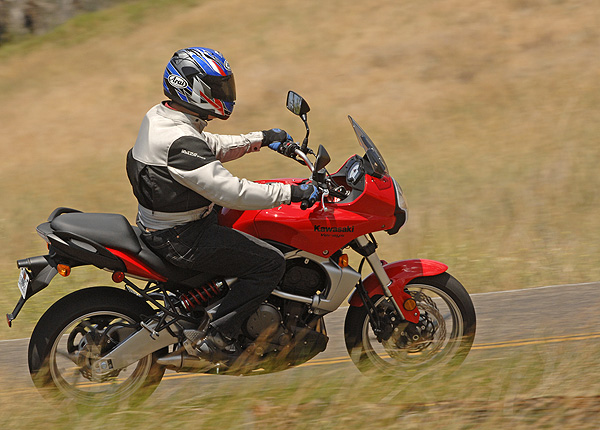
While KTM, Husqvarna and other European manufacturers have been all over the supermoto trend, the Japanese have largely failed to produce anything resembling a state-of-the-art, street legal supermoto bike for sale here in the United States (apologies to Suzuki and its DR-Z400SM). Yamaha’s new 2008 WR250X looks like the real deal, but it will be a while before we have a chance to test this machine.
If you have read the title to this article, and wonder what this rambling introduction is all about, pay attention. The Kawasaki Versys (available in Europe last year) is now here in the United States. It is not a pure supermoto by any means, but it combines some of the supermoto sensations and abilities I described above in a more versatile format (I think Kawasaki calls it “versatile system”). It features a state-of-the-art 649cc parallel twin that was designed and built from scratch by Kawasaki a couple of years ago, which is both lighter and more compact than the parallel twin featured in the Ninja 500 that has been around for several years (decades?).
This liquid-cooled, DOHC twin also powers the Ninja 650R we tested, and fell in love with, when it was introduced in late 2005 (as a 2006 model). You can see our riding impression of that bike here. In the Versys, the motor is tuned for more low-end and mid-range, with less top-end power.
The engine has a 180 degree crank, plus a balancer shaft, that makes it a heck of a lot smoother than your traditional British twin. With ECU controlled digital fuel injection and liquid cooling (not to mention the trick jets that spray oil on the undersides of the pistons to further aid cooling), this is one of the most modern parallel twins in production.
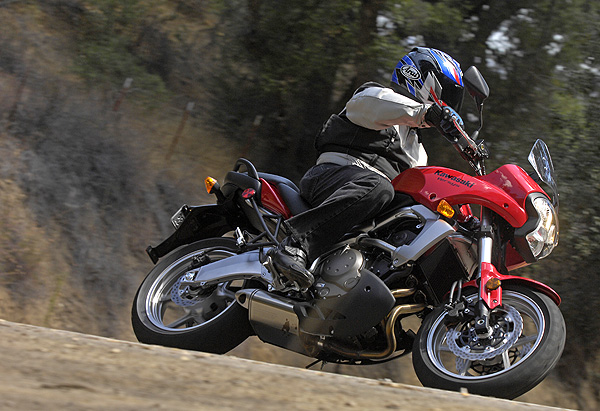
A six-speed transmission is designed to provide all the gear ratios necessary for sane use on the street (or even misuse, if that is your preference). Interestingly, like some race bikes, Kawasaki designed the transmission as a removable cassette.
The trellis steel frame serves to hold the compact powerplant and bodywork in a manner that makes the bike narrow and nimble feeling. The frame and small engine also allow a longer swingarm. That swingarm has a linkage-less Showa shock attached directly to it, which is adjustable for both preload and rebound damping.
A 41mm inverted fork is adjustable for preload and rebound damping and, like the shock, provides more travel than your typical street bike (5.9 inches of travel up front and 5.7 in the back).
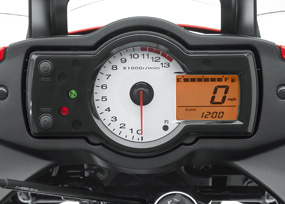
In the braking department, two 300mm petal-shaped discs in front are squeezed by two-piston calipers. The rear brake is a single 200mm petal disc gripped by a single-piston caliper. Fuel tank capacity is a useful 5 gallons (nearly a gallon more than the Ninja 650R).
Instrumentation includes a highly legible analog tachometer and digital speedometer, together with fuel gauge, odometer, dual trip meters and a clock.
We sampled the Versys over a couple hundred miles of Southern California roads, including freeways, high-speed sweeping turns, and extremely tight twisties. The Versys is extremely fun to ride. It is comfortable, handles well, and has some of the supermoto attitude and flickability.
While some supermoto-style bikes are simply too tall, the Versys posed no problem for me (5′ 10″) when it came to getting my feet on the ground. The seat is cut out rather deeply, and the machine is narrow.
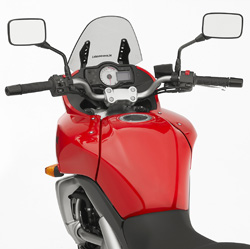
The riding position is comfortable — upright and relaxed, although the seat tends to plant you in a single position that can lead to “seat squirm” after a few hours on the bike.
At a claimed dry weight of 399 pounds, the Versys is not as light as a single-cylinder supermoto racer, of course, but it is much lighter than most street bikes, and nearly as light as many modern sport bikes. With the added leverage of the wide, dirt bike-style handlebars, the Versys changes direction with little effort, and seems to carry that weight well.
The torquey twin also separates the Versys from smaller displacement supermoto-style machines. This bike is powerful enough, and smooth enough, to tour on at relatively high speeds. With few exceptions, smaller displacement singles do not lend themselves to extended freeway touring.
While the Versys had no problem with the high speed cruising, it was in the tight stuff where the bike really stood out. At one point, while descending a very quick succession of switch-backs, I even locked the rear wheel and “backed-it-in” to a few corners, which is something I rarely feel comfortable doing on the street (the dirt is a different matter). The Versys never flinched. The chassis is stiff and controlled — even when pushed like a dirt bike.
The engine has plenty of low-end power to launch you out of those same tight turns. The throttle pick-up is smooth and the power comes on without any hiccups.
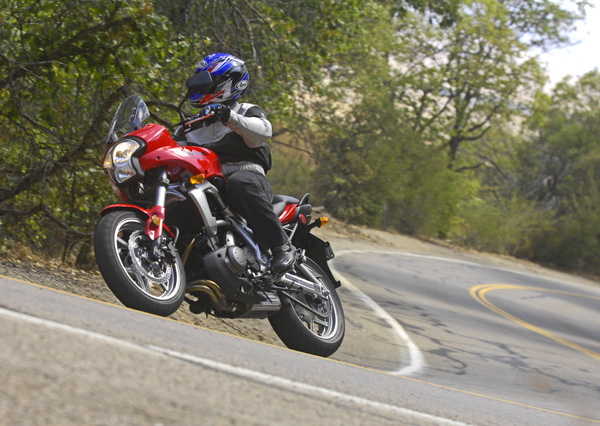
The twin disc brakes up front also had plenty of power. Feel and feedback was probably average, but the brakes were definitely superior to those we sampled on the Ninja 650R.
That extra inch or so of suspension travel is put to good use, although rebound seemed a bit quick, particularly from the fork. After taking the time to slow down the fork rebound slightly, it felt dialed in.
It is certainly a cliche, but the Versys is a confidence-inspiring machine. It is a bike that would work well for inexperienced riders, and still be loads of fun for experienced riders. It is a good reminder that you don’t need mega-horsepower to have fun on the street.
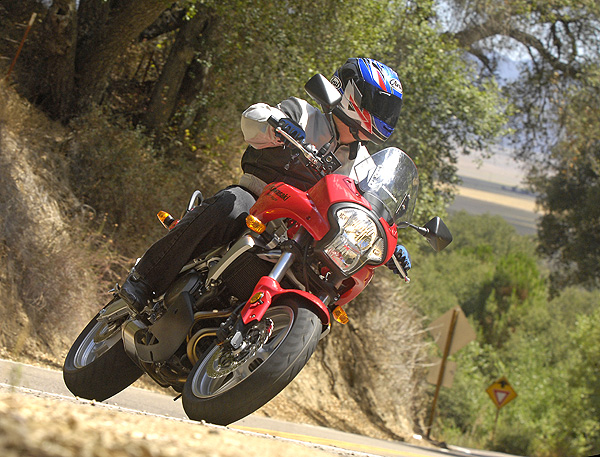
Is it a “versatile system”? I think so. It is a lot more practical than a true supermoto, but provides some of the same thrills. At the same time, you could tour on this thing with a passenger (Kawasaki has optional saddlebags and windscreen available). On top of all that, it is a heck of a lot cheaper than some of the more exotic European supermotos. The Versys carries a U.S. MSRP of just $6,899. These days, mentioning that the Versys should deliver more than 50 miles from a gallon of gasoline is also worthwhile. California residents should note that Kawasaki is not making the Versys available in this state at this time. For additional details and specifications, visit Kawasaki’s web site here.





